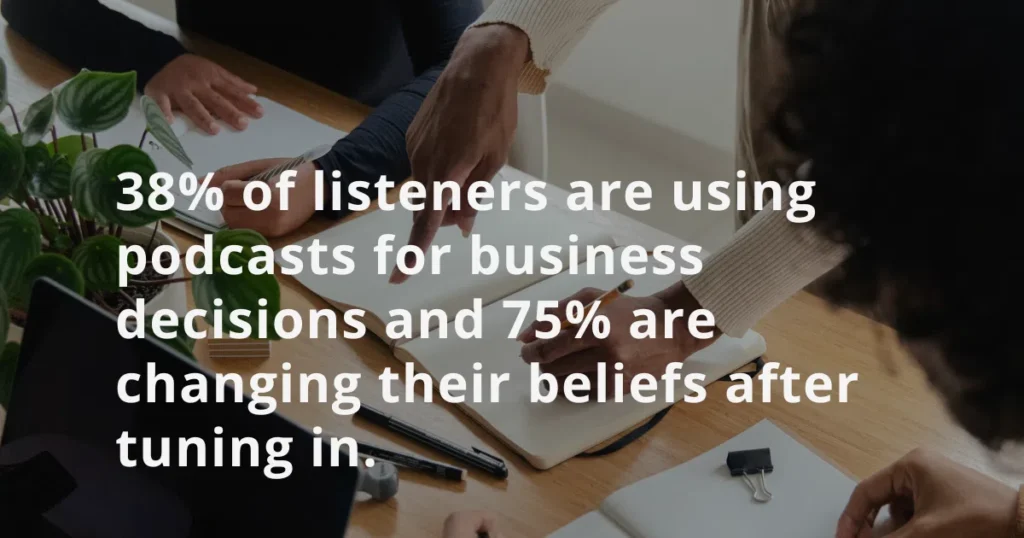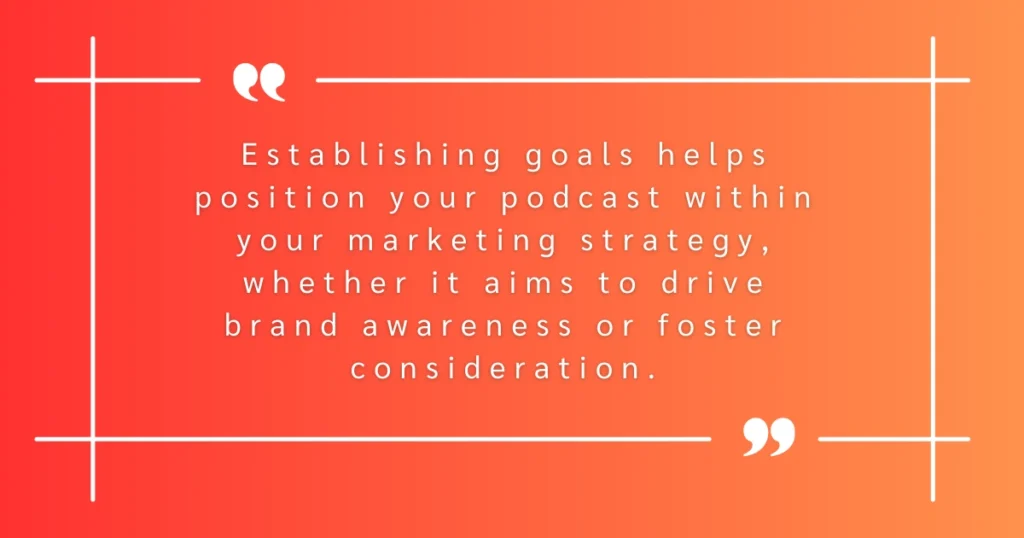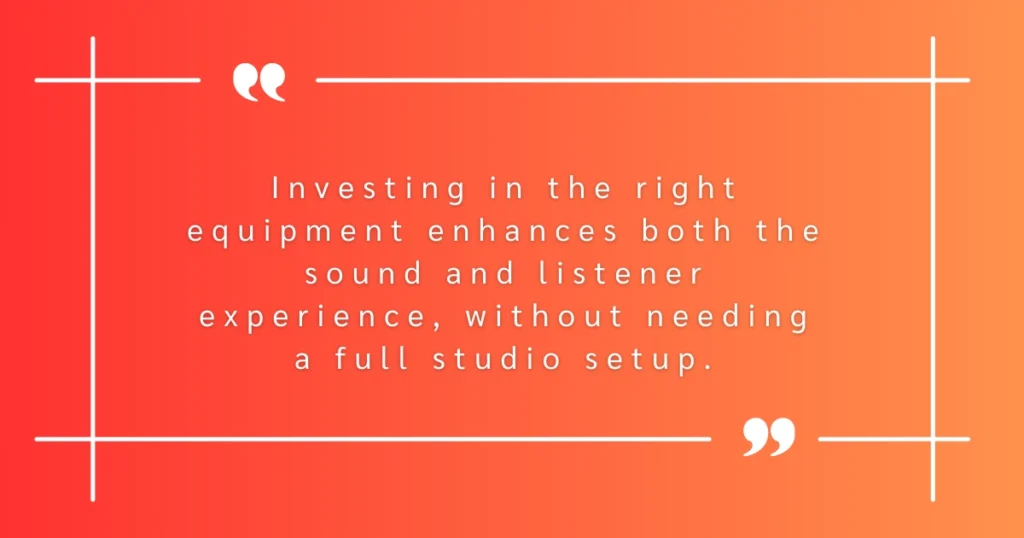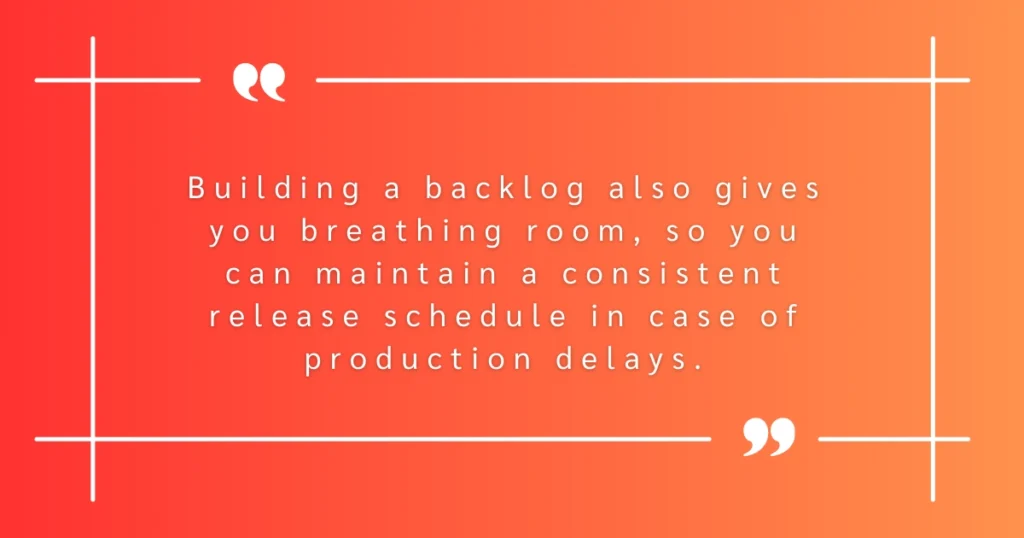Are you tired of battling algorithms and drowning in the noise of saturated marketing channels? A B2B podcast can be your secret weapon for building a loyal audience and making your brand stand out.
Imagine reaching decision-makers during their commute or chores – times when other marketing tactics fall short. With 38% of listeners using podcasts for business decisions and 75% changing their beliefs after tuning in, podcasting offers a unique opportunity to educate and influence your target audience.
Ready to amplify your brand’s voice and showcase your expertise and connect with your ideal listeners? Follow our step-by-step guide on how to start a B2B podcast that delivers measurable ROI and helps your business rise above the noise

1. Align Your B2B Podcast Goals with Business Objectives

Launching a B2B podcast is more than just hitting record it’s about building a marketing asset that supports your wider content marketing and business goals. Before you start a podcast, clarify how it connects to your B2B marketing strategy and what kind of ROI you expect from every episode. A strong B2B podcasting strategy helps your marketing team align on purpose, measure success, and create content that drives measurable growth.
Expert Insight: Abel Grünfeld (Riverside) notes that starting with clear intent “shapes everything from guest selection to episode planning and audience engagement.” A good host and structured goal-setting process can transform a podcast for your business into a long-term growth channel.
Consider these goals for your B2B podcast:
| Podcast Goal | How It Supports Your Business | Example Metric to Measure ROI |
|---|---|---|
| Establish thought leadership | Positions your business podcast as a trusted industry voice | Brand mentions, backlinks, guest invitations |
| Increase brand awareness | Expands your podcast reach across target podcast platforms like Apple Podcasts or Google Podcasts | Unique listeners, impressions, branded search growth |
| Generate qualified leads | Converts podcast listeners into prospects via show notes and CTAs | Lead forms, demo requests, conversions |
| Educate and engage | Uses each podcast episode to deliver insights and create content that fuels marketing efforts | Listener retention, completion rate |
| Repurpose and distribute content | Extends lifespan through blogs, short video clips, and social snippets | Blog engagement, video views, social shares |
| Measure podcast performance | Tracks metrics that prove ROI to stakeholders | Downloads, website traffic, lead attribution |
A clearly defined strategy ensures every episode supports your marketing goals, from content creation to promotion. It also provides a roadmap for your marketing team to evaluate what makes a B2B podcast successful and sustainable.
Hone in on Your Target Audience
When you’re starting a podcast, understanding who you’re speaking to is critical. Defining your podcast audience ensures every episode delivers value, aligns with your content strategy, and reaches the right B2B companies. Whether you plan a solo podcast, interview-based show, or video podcast, your content should resonate with the decision-makers who listen to podcasts for business insights.
For example, impact.com’s podcast, The Partnership Economy, focuses on different types of partnerships brands can form with publishers, while serving broader partnership economy interests.
Use the framework below to sharpen your audience definition and guide how you’ll grow your podcast:
| Audience Attribute | Why It Matters | Example Data or Action |
|---|---|---|
| Industry Segment | Tailors topics to your sector’s pain points | CRM data, audience surveys |
| Role & Seniority | Adjusts tone and depth for executives vs. practitioners | LinkedIn analytics |
| Preferred Type of Podcast | Decides whether to run an interview-based show, solo podcast, or hybrid | Competitor research, listener polls |
| Content Consumption Habits | Determines how you’ll distribute your podcast and promote episodes | Podcast player analytics, email open rates |
| Engagement & Growth Metrics | Helps measure podcast performance and optimize future content | Subscriptions, shares, reviews |
This audience insight becomes the foundation of your B2B podcasting strategy. Keep refining it as your show evolves—your podcast growth depends on how well you listen to your listeners and adapt your content marketing efforts to meet their needs.
2. Choose Dynamic Hosts and a Reliable Production Crew

Choose a passionate, engaging podcast host who can commit to consistent productionand represent your brand authentically. Whether you’re starting a B2B podcast or expanding your content marketing efforts, your host should connect with your podcast audience and lead conversations that reinforce your business goals.
Consider co-hosts for dynamic discussions and stronger guest interactions—especially if your show features podcast interviews or multiple perspectives.
Your podcast team should include:
- Producer/project manager: to coordinate recording schedules and marketing efforts
- Audio editor: to deliver professional-quality sound
- Content manager: to repurpose each podcast episode into blog content or short clips
- Marketer: for promotion to promote episodes and track podcast metrics across podcast platforms
Assess your internal capabilities realistically. If resources are limited, consider partnering with a podcast production agency for expertise and efficiency, especially if you’re aiming to launch a business podcast or produce a video podcast for B2B marketing campaigns
“There are a shocking number of steps to build a podcast,” says Chuck Moxley, CMO at Blue Triangle. “Having a professional production agency who handles the heavy lifting and helps keep you on schedule is critical.”
The impact.com podcast team works with Quill Podcasting to enrich its brand storytelling.
3. Analyze the Competition: What Makes a B2B Podcast Stand Out
Creating a standout podcast starts with offering original, fresh and valuable content that provides new perspectives or dives deeper into existing insights. Take some time to dig into what’s already out there in your niche to see how you can carve out your unique space and pull in listeners.
Check out popular formats, episode lengths, and how different podcasts engage their audiences. Look at what others do well, where they might fall short, and where your podcast can fill in the gaps. And don’t just limit your exploration to direct competitors. Tune in to podcasts you love in other industries to find intriguing elements you can adapt to your B2B podcast.
Pro Insight: If you’re working with a podcast production agency, ask them to run a competitive content audit. Agencies often use data tools like Chartable or Listen Notes to benchmark your show against competitors on metrics such as reach, reviews, and frequency.
| Competitor Behavior | Your Strategic Opportunity | Resulting Advantage |
|---|---|---|
| Covers general marketing topics | Focus on B2B-specific insights and case studies | Builds relevance for B2B marketers |
| Publishes irregularly | Commit to a steady, weekly schedule | Earns listener trust and improves ranking on podcast platforms |
| Offers only audio | Experiment with video podcasts and short clips | Expands podcast reach across YouTube and LinkedIn |
| Doesn’t repurpose episodes | Turn recordings into blog content or newsletters | Strengthens content marketing ROI |
| Uses limited guests | Feature expert podcast interviews from niche industries | Adds authority and increases podcast listeners |
This structured approach transforms competitive analysis into actionable insights, giving your marketing team a roadmap for how to start a podcast that truly fills unmet audience needs.
4. Zero In On Your Podcast’s Format to Engage Listeners and Set Expectations
Setting a consistent structure for your podcast is key to meeting your audience’s expectations. Here are some things to keep in mind:
Episode style: Decide whether your podcast will focus on interviews, solo commentary, or panel discussions. Each style suits different content types. For instance, 37signals’ REWORK uses co-host discussions with occasional internal guests, while The Ecommerce Playbook mixes interviews and expert panels.
Episode length: Align with audience preferences and habits. Aim for a 30-minute episode to fit commutes, but consider shorter segments for quick updates. Riverside notes that short formats help discovery, while longer ones build trust and facilitate monetization.
Episode structure: Determine if you’ll have regular segments and establish a consistent flow for opening and closing episodes to enhance listener engagement.
Release schedule: Choose a feasible frequency for releasing episodes, such as weekly or bi-weekly.
Seasons vs. ongoing: Decide between a seasonal or continuous format. Seasons allow breaks and topic shifts, while ongoing formats maintain engagement.
Don’t be afraid to experiment. Chuck suggests trying different formats to see what aligns best with your podcast’s goals and strategy, as each option has its perks.
5. Invest in Essential Recording Equipment for Quality Audio

Ensuring quality is crucial for a professional podcast, as it builds trust in your brand. Investing in the right equipment enhances both the sound and listener experience, without needing a full studio setup.
Start with these essentials:
- Microphone: Choose one designed for podcasting to ensure clear audio.
- Headphones: Use them during recording to prevent audio bleeds.
- Recording and editing software: Riverside is popular for B2B podcasts, offering high-quality audio and video.
- Transcript software: Transcripts boost accessibility, search discoverability, and content repurposing.
- Recording space: A quiet, echo-free room with a clean background is vital for good sound and video quality.
6. Design your Podcast’s Visual Identity and Media Assets
While podcasts are primarily audio, strong visuals help attract listeners and build brand recognition.
Develop these key assets:
- Logo: Design a versatile logo that works across various platforms and materials.
- Podcast cover art: Create eye-catching artwork for podcast directories. Ensure it’s recognizable even at small sizes and meets platform requirements.
- Episode artwork: Create template designs for individual episode artwork, including space for episode numbers, titles, or guest photos.
- Intro/outro music: Your podcast’s music sets the tone. Just ensure you have usage rights.
As you develop your assets, consider how closely you want your podcast’s brand to relate to your business. Content, Briefly uses Superpath’s signature typeface and orange brand color to tie the two entities together. Though brands with multiple podcasts, like us, tend to create more differentiated visual identities for clarity.
7. Map Out a Compelling Content Calendar
A content calendar is vital for podcast consistency and cohesion. Initially, plan one season at a time, pausing between seasons to analyze and refine your strategy. Before each season, identify topics to cover, including current industry trends, evergreen subjects, and frequent audience questions. Align your podcast with business initiatives. For example, if launching a new product, dedicate episodes to related topics to generate interest.
Experiment with mini-series to tell focused stories that connect with new audiences. Chuck recommends adding wrap-up episodes that summarize guest takeaways and highlight your brand’s insights. When you tag guests on social media profiles, these compilation episodes often outperform single-topic ones—helping you create content for the masses that still feels personal and value-driven.
8. Book Expert Guests to Spark Audience Interest
Running an interview-style podcast? Start by listing industry experts who fit your theme and can offer valuable insights. Reach out early to coordinate schedules, especially with high-profile guests.
Begin with your existing network for easier bookings. You can also invite guests by adding a submission form on your website or using platforms like Help a B2B Writer.
Create a one-sheet or media kit that outlines your podcast’s purpose, target audience, and episode format to attract potential guests. Once you’re launched, include noteworthy stats.
Aim for diverse guests to cover a wide range of topics and perspectives, keeping your show engaging within your chosen niche.
9. Launch Your B2B Podcast Strong: Start with High-Impact Episodes

Kick off your podcast strong with your most engaging topics and high-profile guests to draw people in. It sets a high standard for content quality from the start and gives you compelling episodes to showcase for promotion.
Doing this for our podcast’s first season at impact.com laid the foundation and generated buzz.
Chuck recommends recording several podcasts before you publish. He said, “It will take you some time to get your rhythm and format down, and likely the first episode you want to publish to start your podcast won’t be the first one you record.”
Building a backlog also gives you breathing room, so you can maintain a consistent release schedule in case of production delays.
10. Leverage Podcast Content Across Channels to Grow Your Audience

Getting your podcast out there starts with choosing the right hosting platforms. Think of Apple Podcasts and Spotify as your go-tos, and if you’re rocking video content, YouTube is a must—it’s really picking up steam for B2B podcasts.
Now, let’s talk promotion. Start small with organic strategies. Share snippets or quotes from your episodes on LinkedIn or Twitter to get the conversation going, and don’t forget to include your latest episodes in your email newsletters. Once you have a few episodes live, you can dive into paid ads to reach even more listeners.
Make sure your hosts and guests are in on the action too. Ask them to share episodes with their networks, especially if you’ve got a guest with a big following. Make it easy for them by providing shareable goodies like video clips or graphics.
As your audience grows, encourage reviews and ratings—they’re like gold for attracting new listeners. And don’t stop there. Grünfeld recommends repurposing your episode content to keep the buzz going. Use clips for social media posts, weave them into ABM campaigns or email marketing, and sprinkle quotes throughout your blog. This way, your podcast content becomes a powerhouse for your brand across all channels.
Keep Your Podcasting Strategy Growing: Measure Podcast Metrics and Celebrate Wins
Congratulations on your B2B podcast launch! Track your key metrics from the North Star document to ensure you’re on target. Listen to your audience through reviews and comments to understand what they enjoy.
Analyze why some episodes perform better—consider the topic, guest, or promotion strategy. Building a successful podcast takes time, so don’t sweat slow growth. Consistently deliver quality content and engage your audience. Chuck suggests not aiming for the top 100, but focusing on reaching the right listeners who matter to your niche.
Celebrate each milestone, whether it’s hundreds or even dozens of the right listeners. With continuous learning and improvement, your podcast will become a powerful brand-building tool.
Happy podcasting!
Frequently Asked Questions: Starting a B2B Podcast
By featuring expert interviews, customer success stories, and strong points of view on industry trends, your podcast becomes a trusted source of insight. Over time, consistent publishing builds authority, increases branded search, and boosts visibility across search, social, and distribution platforms.
Great sound quality, clear show notes, reliable episode cadence, and easy access on all major platforms. Adding episode chapters, resource links, and CTAs aligned to your marketing goals improves listener satisfaction and keeps audiences coming back.
Start with simple, reliable tools: Riverside, Descript, or Audacity for recording and editing; a USB microphone with a pop filter; closed-back headphones; and an audio interface if you use XLR mics. For video podcasts, a Logitech Brio 4K webcam—or even an iPhone with a Stouchi Continuity Camera Mount—works well.
Not necessarily. A treated room, good mic technique, and basic sound isolation can rival a professional studio. For launches or high-stakes episodes, studio hire can help you lock in premium audio and video quality.
Document your ideal listener’s role, seniority, pain points, desired outcomes, and preferred format (solo, interviews, or panels). This clarity shapes your episode topics, length, and the type of B2B show that best serves your niche.
Success metrics for a business podcast include downloads, listener growth, episode completion rate, website traffic, leads generated from show notes, and branded search lift. Tie each metric back to your original business goals—whether that’s thought leadership, audience growth, or demand generation. Use analytics from your hosting platform and compare performance across seasons to identify what topics, guests, or formats resonate most with listeners.
Repurpose episodes into short-form video clips, blog posts, email snippets, and LinkedIn content. Map each asset to your marketing funnel—ABM campaigns, landing pages, or newsletters—to maximize brand visibility and extend every episode’s reach.
Submit your RSS feed to major platforms like Apple Podcasts, Spotify, and YouTube. Embed a podcast player on your website for SEO and user experience. Keep your social profiles updated to support cross-promotion and link building.




